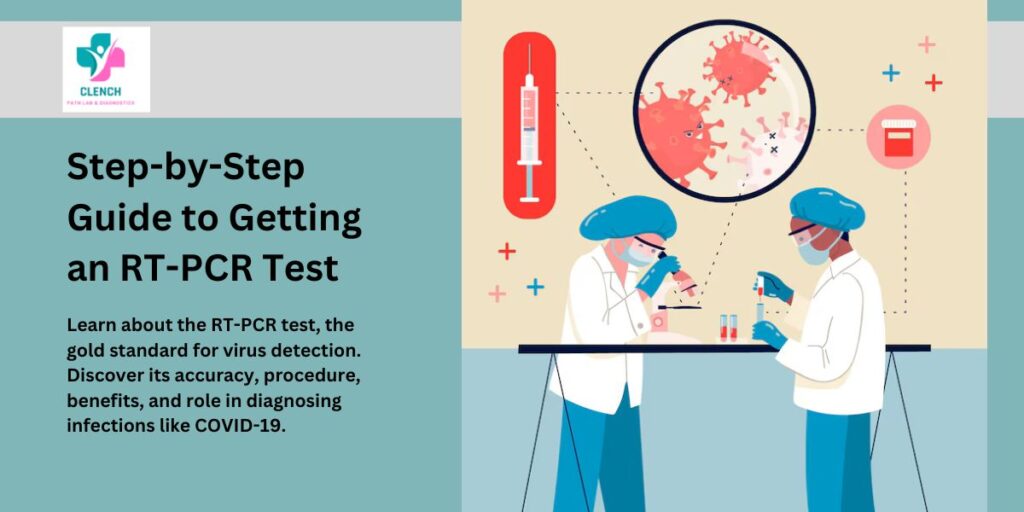The RT-PCR test, short for Reverse Transcription Polymerase Chain Reaction, is a widely used diagnostic tool that has gained significant prominence, especially during the COVID-19 pandemic. This highly sensitive and specific test helps detect the genetic material of viruses, making it an invaluable asset in controlling the spread of infectious diseases like COVID-19. This blog delves into the nuances of the RT-PCR test, its methodology, applications, and its critical role during the pandemic.
What is an RT-PCR Test?
The RT-PCR test is a molecular diagnostic tool that detects RNA (ribonucleic acid) from a pathogen, such as the SARS-CoV-2 virus responsible for COVID-19. Unlike traditional diagnostic methods, RT-PCR combines reverse transcription of RNA into DNA with amplification techniques, enabling the detection of even minute traces of viral genetic material.
This test has become the gold standard for diagnosing COVID-19 due to its accuracy and reliability. Laboratories worldwide use it to confirm cases, and governments rely on RT-PCR test results to frame health policies and control strategies. As a type of genetic testing, the RT-PCR test analyzes the genetic material of the virus to detect its presence with precision.
How Does the RT-PCR Test Work?
The RT-PCR test involves a multi-step process that ensures precision. Here’s how it works:
Sample Collection
The process begins with collecting a sample from the patient. This is typically done using a nasopharyngeal or oropharyngeal swab, though saliva samples are also acceptable in some cases.
RNA Extraction
Once the sample is collected, it is treated with chemicals to extract RNA, including any viral RNA present.
Reverse Transcription
The extracted RNA is converted into complementary DNA (cDNA) using an enzyme called reverse transcriptase. This step is essential since PCR amplification works with DNA, not RNA.
DNA Amplification
The cDNA is subjected to amplification through cycles of heating and cooling. This is done in a thermal cycler, where primers and probes target specific viral genes. If the virus’s genetic material is present, it will be amplified and detected.
Result Analysis
The amplified genetic material is analyzed, and the results are interpreted. Positive cases yield detectable signals, whereas negative cases show no amplification.
Why is the RT-PCR Test the Gold Standard?
The RT-PCR test result is considered the most reliable diagnostic method due to several factors:
High Sensitivity
It can detect even low levels of viral RNA, making it effective in early-stage infections.
High Specificity
The primers and probes used are designed to target specific sequences, minimizing false positives.
Versatility
While primarily used for COVID-19, the RT-PCR test can also detect other pathogens, including influenza, Zika virus, and hepatitis.
The Role of RT-PCR Tests During the COVID-19 Pandemic
During the COVID-19 pandemic, the RT-PCR test became the cornerstone of global testing strategies. Governments and healthcare providers relied on COVID-19 test reports to identify and isolate infected individuals, monitor the spread of the virus, and implement containment measures.
The ability of the RT-PCR test to provide accurate COVID-19 test reports made it indispensable in diagnosing cases and differentiating COVID-19 from other respiratory illnesses. This, in turn, informed public health interventions, travel protocols, and vaccination campaigns.
Interpreting RT-PCR Test Results
Positive Results
A PCR test positive result indicates the presence of viral RNA, confirming an active infection. It necessitates immediate isolation to prevent further spread.
Negative Results
A negative result means that no viral RNA was detected. However, this does not rule out infection entirely, especially if the test was conducted early in the incubation period.
Inconclusive Results
In rare cases, results may be inconclusive, requiring a repeat test. This can happen due to insufficient sample collection or technical errors.
Advantages and Limitations of the RT-PCR Test
Advantages:
Accurate Diagnosis
Provides definitive results, reducing the need for follow-up tests.
Early Detection
Detects infections even before symptoms appear, enabling timely treatment.
Widespread Applicability
Useful for both symptomatic and asymptomatic individuals.
Limitations:
Time-Consuming
The test requires specialized equipment and trained personnel, leading to delays in processing.
Cost
RT-PCR tests are more expensive than rapid antigen tests, limiting accessibility in some regions.
Sensitivity to Contamination
Sample contamination can lead to false positives or negatives.
Conclusion
The RT-PCR test has played a pivotal role in managing the COVID-19 pandemic, enabling timely and accurate detection of infections. Its high sensitivity, specificity, and reliability make it the gold standard for diagnostic testing. Alongside tests like the Liver Function Test, which assesses liver health, the RT-PCR exemplifies the integration of diverse diagnostic tools in modern medicine. Understanding its methodology and limitations is essential for interpreting COVID-19 test reports effectively. Whether diagnosing a patient or curbing a pandemic, the RT-PCR test highlights the power of molecular diagnostics in healthcare.
Read more Blog: Diabetes Checkup
FAQs About the RT-PCR Test
1. What is the turnaround time for RT-PCR test results?
The time to receive RT-PCR test results varies but typically ranges from 12 to 48 hours, depending on the lab’s capacity and workload.
2. Can the RT-PCR test detect variants of COVID-19?
Yes, RT-PCR tests can detect variants if the targeted genes remain conserved. Specialized assays may be required for variant-specific detection.
3. What should I do if my PCR test positive result is confirmed?
If your result is positive, isolate immediately, inform close contacts, and follow healthcare provider instructions. Seek medical attention if symptoms worsen.
4. How accurate is the RT-PCR test compared to other tests?
The RT-PCR test is more accurate than rapid antigen tests, with higher sensitivity and specificity, making it the preferred diagnostic method.
5. Can a negative RT-PCR test result guarantee that I am COVID-free?
A negative result reduces the likelihood of infection but does not guarantee it. Retesting may be necessary if symptoms persist or exposure is suspected.
